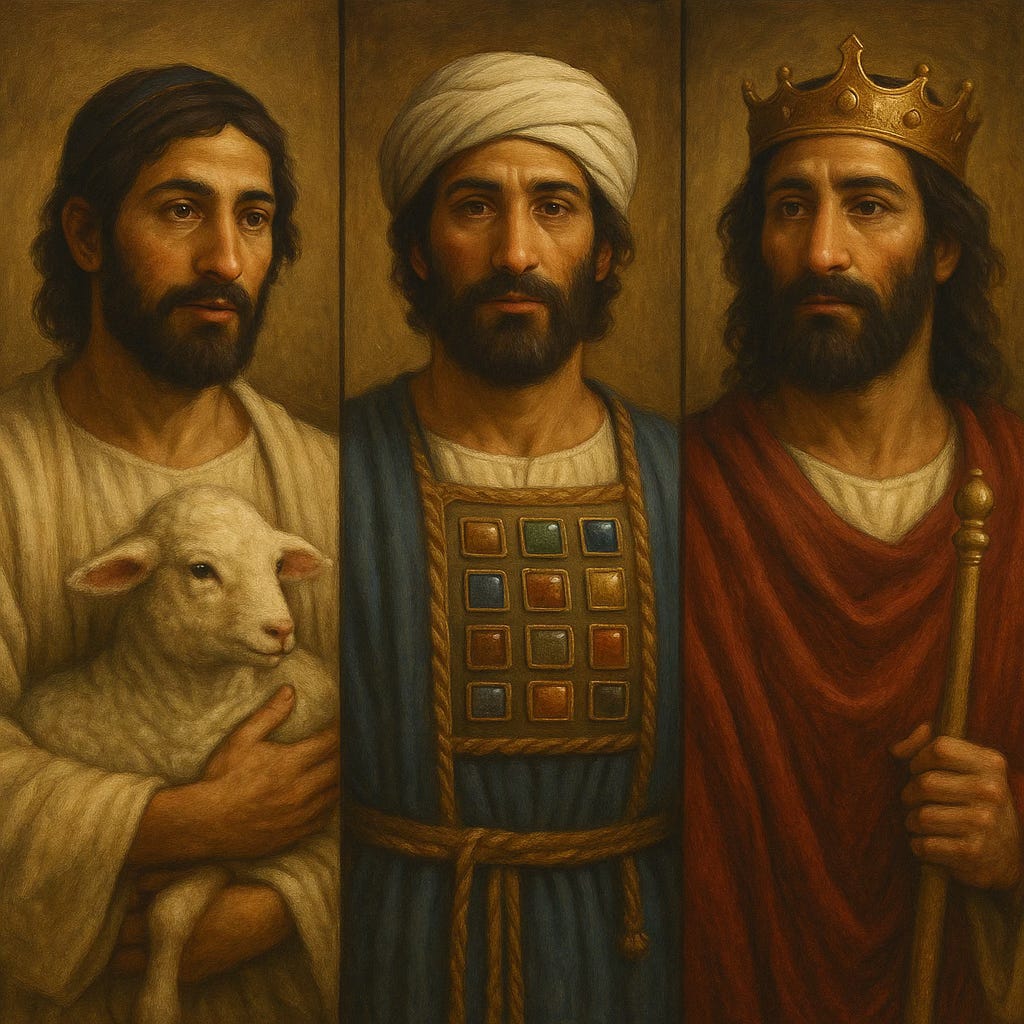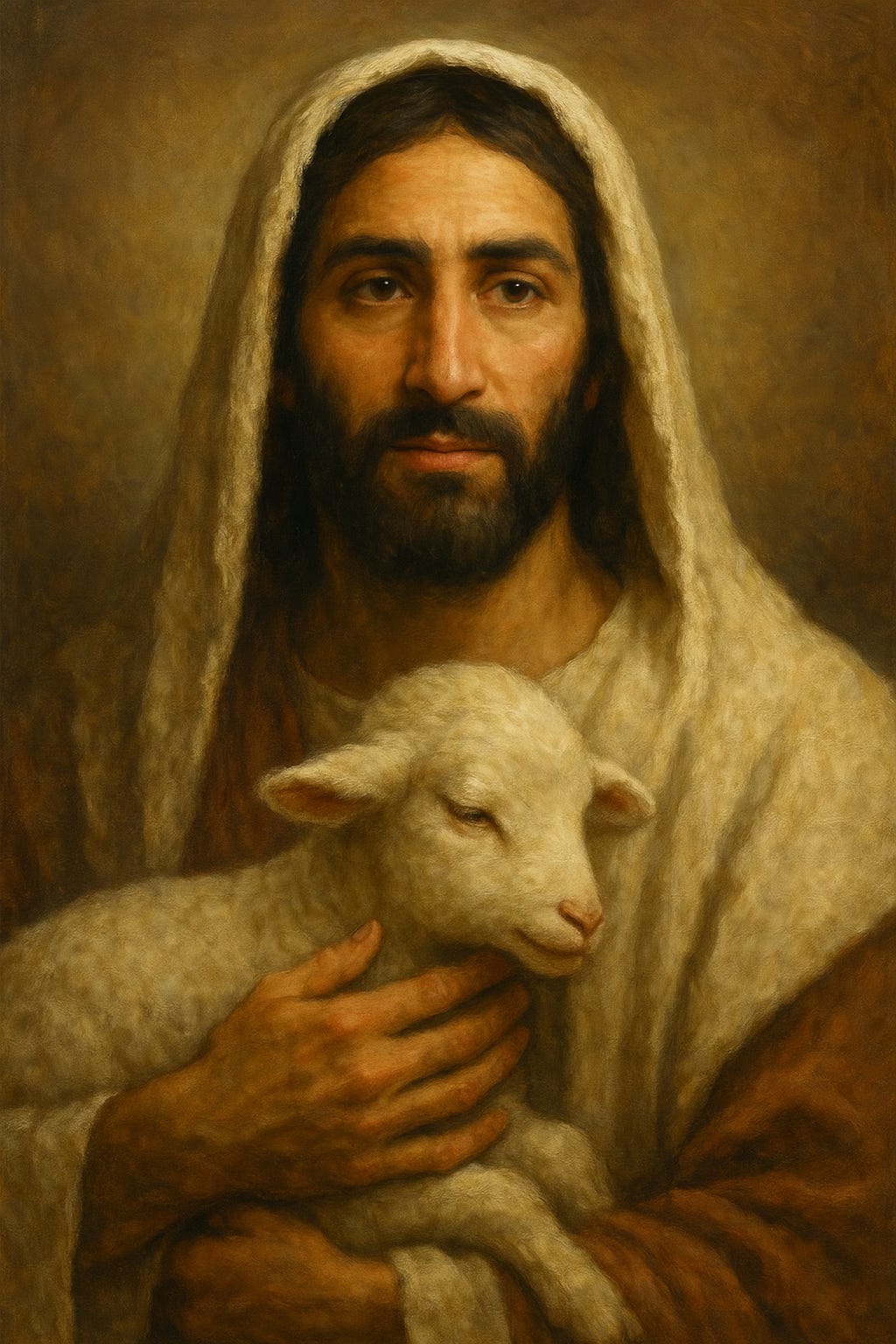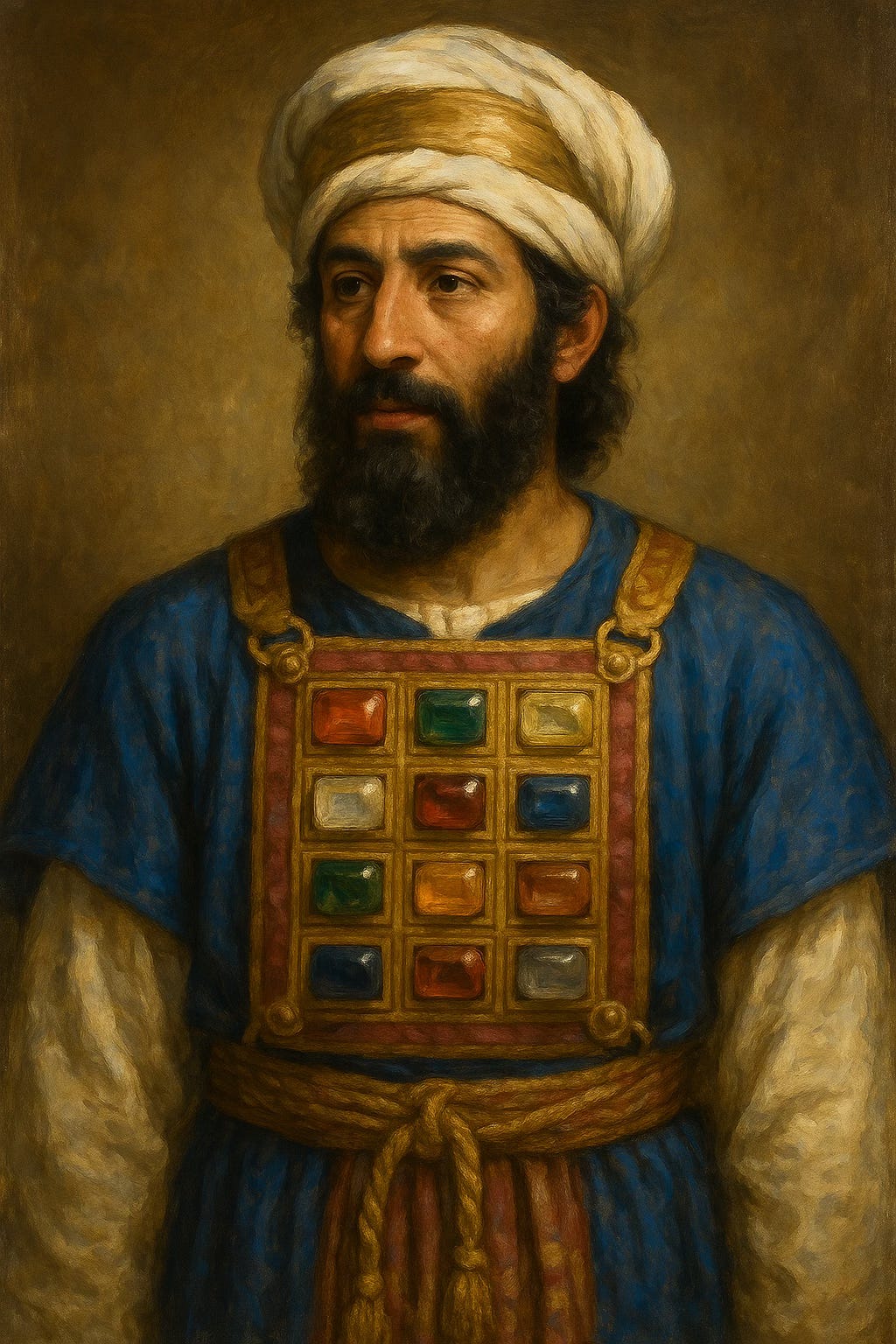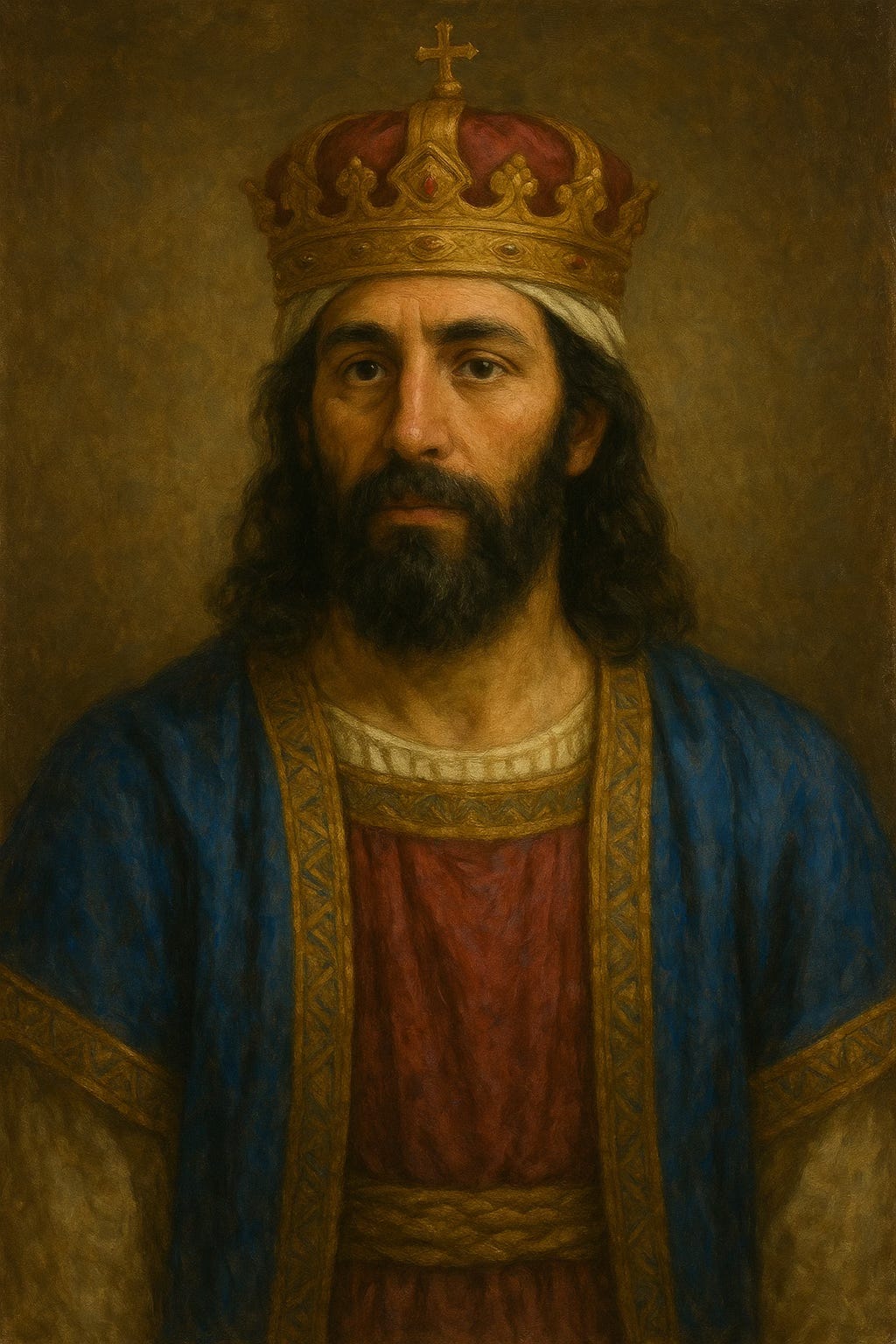Beholding Christ: The Lamb Who Was, the Priest Who Is, and the King Who Is to Come I
4-Part series on How revelation of Jesus shapes our lives, and transforms us.
Welcome to a 4-Part series on How revelation of Jesus shapes our lives, and transforms us. These posts developed from meditations on teachings from Peter Louis. @peterklouis on instagram
Imagine for a moment standing beneath a blood-stained cross. The earth trembles, darkness covers the sky, and there, hanging in agony, is Jesus, the Lamb, silent before His shearers, bearing the weight of humanity’s sin. Now, picture yourself outside an empty tomb. The stone rolled away, grave clothes neatly folded, victory echoing through an empty chamber. Finally, lift your eyes toward the heavens, where Christ sits enthroned, interceding faithfully as our High Priest and poised as the Bridegroom King ready to return. This is the glorious mystery and reality of the Gospel.
The Gospel isn't merely a ticket punched to escape hell; it is an environment in which you and I are rescued, renewed, and reshaped into the image of Jesus Himself. Spiritual maturity doesn't blossom from religious performance or transactional prayer; it thrives in the soil of beholding. Transformation happens as we gaze upon Jesus, who was, who is, and who is to come. The Gospel wasn’t for yesterday, It’s also for today, and for everyday until the Return of our beloved. We didn’t just convert, we are being converted into the image of Jesus.
Jesus the Lamb: Our Redemption Accomplished (Past)
John the Baptist’s declaration, “Behold the Lamb of God,” wasn’t poetic language or spiritual metaphor, it was prophetic precision. An unveiling. A finger pointing across centuries of sacrificial shadow toward the substance. That title, the Lamb, was loaded with memory and meaning. It reached back to Egypt, to doorposts marked by blood and households spared by grace. It echoed through temple courts filled with the cries of animals offered day after day. And now, here in the Jordan River, John says: This is Him. The true and better Lamb. The spotless One who won’t just cover sin, but take it away. Isaiah had seen Him centuries earlier, “like a lamb led to the slaughter” (Isaiah 53:7). Silent. Innocent. Willing.
Augustine captures the tension with stunning clarity: “God had one Son on earth without sin, but never one without suffering.” And it was through that suffering, through the stripes, the scourge, the blood, that redemption was not simply offered but accomplished. Hebrews 10:12 tells us Jesus, after making one sacrifice for sins forever, sat down. That’s the posture of completion. That’s the priest who finished what no other priest could. And when He cried, “It is finished” (John 19:30), it wasn’t a sigh of defeat, it was the thunderclap of victory. The curse was broken. The veil was torn. The debt was paid.
This isn’t distant theology, it’s your access point. The blood of the Lamb is not a symbol we honor; it’s a door we walk through. Right now. Today. Without shame. Without fear. The reason you can come boldly before God is not because you finally got it together, but because the Lamb was slain. The cross isn’t just an event in history; it’s the hinge of eternity. The moment that silenced shame and secured sonship. The moment heaven’s door was flung wide, and stayed open.
Jesus the Priest: Our Redemption Applied (Present)
But the story doesn’t end with a cross or an empty tomb, it continues with a throne and mercy seat. Jesus didn’t just rise and vanish; He ascended to reign, yes, but also to intercede. He took on the eternal mantle of High Priest, and right now, this very moment, He’s ministering in the heavenly tabernacle on your behalf (Hebrews 7:25). This isn’t some distant theological idea tucked away in a dusty doctrine; this is the daily reality of grace that holds you when everything else feels like it’s slipping through your fingers. Hebrews 4:15 tells us He sympathizes with our weaknesses, YES! He gets it. He’s not far off, peering down in disappointment. He’s in the holy place, speaking your name, bearing your need.
When you feel numb in prayer or dry in worship, when your soul is quiet but not in the good way, when you’re caught between guilt and longing and you don’t know how to come near again, it’s Jesus who intercedes. Not vaguely. Not passively. Actively. Personally. Prayerfully. Gregory of Nazianzus said it like this: “What He has not assumed, He has not healed.” And He assumed all of it. Every ache. Every weight. Every sleepless night and silent failure. That means nothing in you is outside His reach, nothing too fragile for His mercy, too complicated for His compassion. Jesus the Priest ensures you are never alone, never abandoned, never unworthy of approach. You are forever covered by His grace.
Jesus the King: Our Redemption Fulfilled (Future)
Yet the Gospel doesn’t end with the Lamb on the altar or the Priest at the throne, it crescendos toward a future moment so radiant, so final, that every story finds its meaning there. Jesus is coming again, in unveiled majesty. Not to suffer, but to reign. Not just as the Lamb, or even just as the Priest, but as the King of Glory and the Bridegroom of His people (Revelation 19:11–16). This isn’t symbolic flourish. This is the climax of redemption. The sky will split. The rider on the white horse will come. John said: His eyes like fire, His robe dipped in blood, and written on His thigh: King of kings and Lord of lords. And on that day, every crown will be cast down, every nation will bow.
Why does the King return?
Because He’s not coming back for an audience, He’s returning for a Bride. This isn’t a cleanup operation. It’s a wedding. A reunion. A reclaiming of what was always His. Christ’s return isn’t just about judgment or finality; it’s about fulfillment. It’s about presenting to Himself a radiant Church, holy, blameless, washed in the water of the Word (Ephesians 5:27). It’s the Groom stepping into the room, not to scold but to celebrate. Revelation 19 paints the moment in striking clarity: the marriage of the Lamb has come, and His Bride has made herself ready. This is the end goal of history, not destruction, but union.
As Timothy Keller insightfully put it, “Christ returns not just to judge but to reclaim His beloved.” Judgment is real. Righteousness will be upheld. He comes to dwell. To reign. To dance with His people in the New Jerusalem, where the veil is gone, the curse is broken, and God is once again with us.
But what was the intended result of all of this, from incarnation to crucifixion to resurrection to return?
It was always transformation. Not just behavior modification, not just forgiveness, but total remaking. Paul says it plainly: “We all, with unveiled face, beholding the glory of the Lord, are being transformed into the same image” (2 Corinthians 3:18). That’s not metaphor. That’s destiny.
The cross sets us free (Galatians 5:1), the Spirit sanctifies us (Romans 8:29), and the glory that once made prophets tremble now makes sons and daughters whole. We are being shaped.
That is freedom.
That is holiness.
That is the kind of communion that runs deeper than ritual and longer than this life.
And as Augustine so famously said, “Christ became human so that humanity might become divine.”
In fellowship, we are welcomed into the glory of God. We are drawn into the life of the Trinity. We become, by grace, what we could never become on our own: people filled with the fullness of God.
That’s the result Jesus died for. And that’s the glory He’s returning to complete.
That glorious appearing reshapes how we wait, how we worship, how we walk through the tensions of now. 1 John 3:2–3 tells us that those who hope in His return purify themselves even now. Why? Because you prepare differently when you know the Bridegroom is on His way.
So we live in the tension of the in-between. Caught between what has been accomplished and what will be revealed. But that tension is sacred. It’s not a burden, it’s a call to remain tender. Anchored. Joyfully expectant. Because the King is coming. And He’s bringing glory with Him.
Four Questions That Keep You Alive in Christ
To truly engage with this Gospel
past, present, and future
we must continually ask ourselves four foundational questions:
Who is He? Consider the depth of who Jesus is, as Lamb, Priest, and King. Reflect on the beauty and mystery of God revealed through each role.
What did He do? Beyond mere historical facts, meditate deeply on the implications of Christ’s life, death, resurrection, and current heavenly ministry.
Why did He do it? This question draws us near to the heartbeat of God. Jesus didn’t act out of cold obligation but profound, divine love. Augustine again reminds us: “God loves each of us as if there were only one of us.”
What was the intended result? God’s aim wasn’t just to cleanse us; it was to transform us into living reflections of Christ Himself (Romans 8:29). The Gospel’s ultimate goal is your ongoing renewal and transformation.
As you journey through these truths, your faith will move from abstract theology to personal reality. Keep beholding Jesus, the Lamb who was slain, the Priest who ministers faithfully, and the King who is returning in glory. Let your heart remain soft, your faith vibrant, and your life deeply rooted in Him.
Here are meditation verses to anchor and deepen reflection on each foundational question.
1. Who is He?
Consider the depth of who Jesus is, as Lamb, Priest, and King.
Lamb:
“The next day he saw Jesus coming toward him, and said, ‘Behold, the Lamb of God, who takes away the sin of the world!’” (John 1:29 ESV)
Priest:
“For we do not have a high priest who is unable to sympathize with our weaknesses, but one who in every respect has been tempted as we are, yet without sin.” (Hebrews 4:15 ESV)
King:
“On his robe and on his thigh he has a name written, King of kings and Lord of lords.” (Revelation 19:16 ESV)
2. What did He do?
Meditate deeply on Christ’s life, death, resurrection, and heavenly ministry.
Life:
“And the Word became flesh and dwelt among us, and we have seen his glory, glory as of the only Son from the Father, full of grace and truth.” (John 1:14 ESV)
Death:
“He himself bore our sins in his body on the tree, that we might die to sin and live to righteousness. By his wounds you have been healed.” (1 Peter 2:24 ESV)
Resurrection:
“He is not here, for he has risen, as he said. Come, see the place where he lay.” (Matthew 28:6 ESV)
Heavenly Ministry:
“Consequently, he is able to save to the uttermost those who draw near to God through him, since he always lives to make intercession for them.” (Hebrews 7:25 ESV)
3. Why did He do it?
Draw near to the heartbeat of God and His divine love.
Love’s Motivation:
“But God shows his love for us in that while we were still sinners, Christ died for us.” (Romans 5:8 ESV)
Personal Love:
“I have been crucified with Christ. It is no longer I who live, but Christ who lives in me. And the life I now live in the flesh I live by faith in the Son of God, who loved me and gave himself for me.” (Galatians 2:20 ESV)
Eternal Love:
“In this is love, not that we have loved God but that he loved us and sent his Son to be the propitiation for our sins.” (1 John 4:10 ESV)
4. What was the intended result?
Reflect on God’s purpose: your ongoing transformation into the likeness of Christ.
Transformation Goal:
“For those whom he foreknew he also predestined to be conformed to the image of his Son, in order that he might be the firstborn among many brothers.” (Romans 8:29 ESV)
Renewed Creation:
“Therefore, if anyone is in Christ, he is a new creation. The old has passed away; behold, the new has come.” (2 Corinthians 5:17 ESV)
Christ Formed in You:
“My little children, for whom I am again in the anguish of childbirth until Christ is formed in you!” (Galatians 4:19 ESV)








